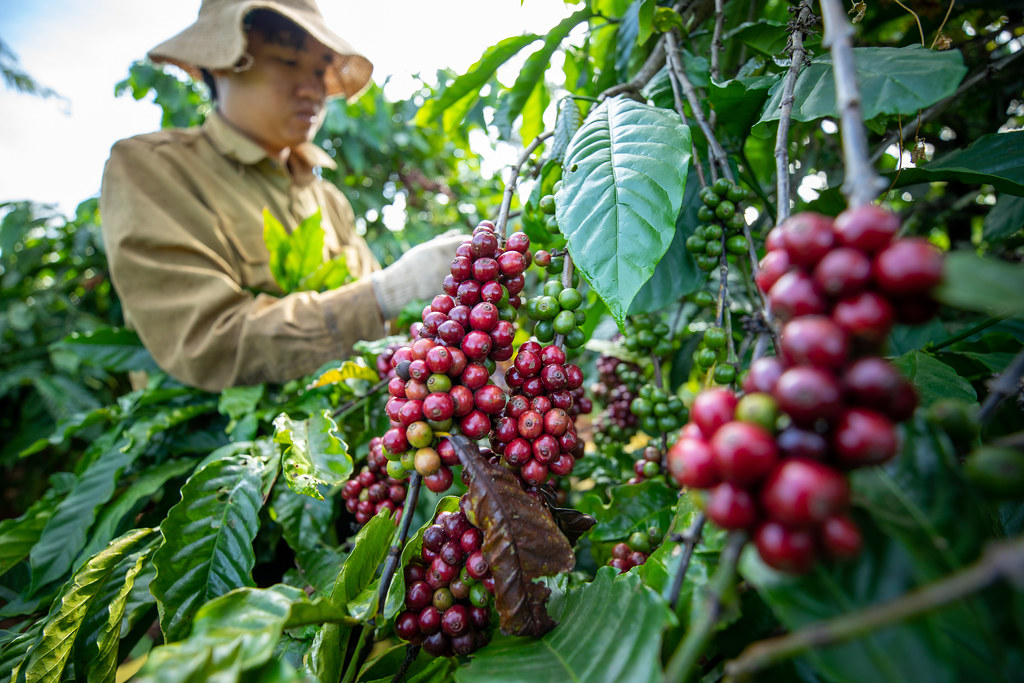Coffee lovers, pay attention. You won't believe this—we have an announcement! If you're passionate about your daily brew but also care about the planet, you're in for a treat. With climate change a growing concern, eco-conscious coffee drinkers are on the rise. Sustainable bean farming is their focus; it lessens the industry's environmental effect.
The products we choose—they're more than just products. Consider them statements of fact. Statements about what kind of world we want. Better coffee growing practices are supported when you choose sustainable beans.
So, what exactly makes coffee eco friendly? How can you find the most environmentally friendly coffee options? This makes all the difference. A lot. Think of it like this: [brief analogy explaining the benefit]. Get ready for a deep dive into this, and a whole lot more besides! Get ready. Get ready to discover how your morning cup, whether it's ground coffee for a drip machine or bean coffee for a French press, can contribute positively.
Table Of Contents:
- What Makes Coffee Environmentally Friendly?
- Eco-friendly coffee: What's the effect?
- How to Find Environmentally Friendly Coffee
- Brewing Environmentally Friendly Coffee at Home
- Environmentally conscious coffee: A look ahead.
- Producing environmentally sound coffee presents many difficulties.
- Making the Switch to Environmentally Friendly Coffee
- Conclusion
What Makes Coffee Environmentally Friendly?
Environmentally friendly coffee isn't just a trendy label. It's all about a smart way to grow, process, and get coffee to you—while being kind to the planet. A few key things make coffee more environmentally friendly; it's more than just using traditional methods.
Understanding these factors helps appreciate the effort behind conscious coffees. Consumers find the information they need to select the perfect cup of coffee. We aim to make your purchase a positive one; you'll be satisfied with the result.

Sustainable Farming Practices
Farmers growing environmentally friendly coffee employ methods that nurture the soil and protect surrounding ecosystems. Organic farming is their preferred method; they avoid chemical fertilizers and pesticides. Biodiversity is preserved; soil health, vital for future coffee plants, is maintained; and water sources are protected from chemical pollution. A win for you, a win for me, a win for them! Right on!
Composting coffee pulp and natural pest control are common practices. You'll get more resilient coffee crops if you focus on healthy soil. This is fundamental to a successful harvest; the soil is the foundation. Sustainable coffee depends on responsible land management over the long haul.
Water Conservation
Coffee production, particularly the "wet processing" method used for many high-quality arabica beans, can demand significant amounts of water. Smart irrigation, rainwater collection, and water recycling—that's how eco-conscious coffee farms are making a difference. Protecting our water sources is as simple as using less of it. Safeguarding our rivers and groundwater is what this accomplishes; it keeps them clean.
Some innovative farms even utilize systems like rainwater-driven restrooms or solar water-heated systems for cleaning equipment. Drought-prone coffee regions need to use less water; it's a serious issue. Support water conservation: Choose coffee beans from farms committed to water stewardship.
Shade-Grown Coffee
A significant portion of environmentally friendly coffee beans are cultivated under a natural forest canopy. This traditional "shade-grown coffee" method contrasts sharply with "sun-grown" coffee, which requires clearing forests. Biodiversity gets a boost from shade canopies which provide a rich habitat for many animals. Picture birds and bugs on the move!

Shade trees also enrich the soil naturally through leaf litter, reducing the need for chemical fertilizers. Because of their extensive root systems, trees help keep hillsides from washing away. Carbon sequestration by the trees themselves contributes significantly to climate change mitigation efforts; it's a natural process with a substantial impact. Did you know that buying shade-grown coffee directly benefits the planet? Forest ecosystems are saved by this.
Eco-friendly coffee: What's the effect?
Choosing eco-friendly coffee offers more than just a great morning brew. Protecting the environment and supporting coffee farmers—that's what this choice does. Consumers wield real power: What customers think matters a lot. The coffee industry hears them loud and clear. Buying coffee thoughtfully can promote better farming practices and worker rights. The outcome is readily apparent; it's quite clear. It's noticeable.
Positive things happen; ecosystems, farms, and even the world's weather improve. Sustainable coffee farming matters a lot. The world's coffee supply needs them to survive.
Protecting Ecosystems
Conventional coffee farming is a major driver of deforestation, especially when forests are cleared for sun-tolerant varieties. Environmentally friendly coffee methods, particularly shade-grown techniques, help preserve vital forest habitats. The health of these habitats and the fight against climate change are deeply connected; one cannot succeed without the other. Consider this: healthy habitats are like the Earth's lungs, cleaning the air and regulating the climate. Think of all the species that depend on them for survival – it’s a huge web of life!
Sustainable coffee farming and tree cover go hand-in-hand to safeguard biodiversity. Many of these rich ecosystems are in coffee-growing areas. Think of the Amazon rainforest, for example. Coffee production there directly impacts biodiversity. Protecting watersheds and stopping soil loss—that's what this does. Protecting our natural resources is easier when we pick sustainable choices.
Supporting Farmers

Many eco-friendly and ethical coffee initiatives, like Fair Trade and direct trade models, focus on ensuring farmers receive fair compensation for their coffee beans. These programs pay more than the usual price; the extra money goes right back into the community. Schools, hospitals, and infrastructure projects—all could benefit from this investment.
Brands like Equal Exchange are built on fair partnerships with farmer cooperatives. Better wages, better farms, better practices—that's what supporting these programs does for coffee growers. We've built a more equitable and resilient system; the coffee supply chain is better for everyone now.
Reducing Carbon Footprint
Sustainable coffee practices generally lead to lower greenhouse gas emissions compared to conventional methods. Organic farming eliminates the emissions associated with synthetic fertilizer production, while shade-grown systems sequester carbon in trees and soil. Reduced energy consumption in processing and transportation also contributes to a smaller overall carbon footprint.
Some environmentally friendly coffee brands go further, aiming for carbon neutral status by measuring their emissions and investing in carbon offsets. Choosing brands with a tiny footprint, like Tiny Footprint Coffee, directly supports climate action. Coffee growing needs to be more eco-friendly to help stop global warming.
How to Find Environmentally Friendly Coffee
Ready to make the switch and buy coffee that aligns with environmental values? It's getting simpler to find green choices; consumer demand is rising. Here's what to look for when searching for the best eco friendly coffee:
Being an informed consumer is the first step. Don't just believe the hype; check the facts about sustainability.
Certifications

Several independent organizations offer certifications that verify adherence to specific environmental and ethical standards. Sustainable coffee is easy to find—just look for these labels! Look for these prominent certifications on coffee bags:
- USDA Organic: Guarantees the coffee was grown without synthetic pesticides, herbicides, or fertilizers, promoting soil health. This is a standard that a lot of organic coffee brands follow.
- The Rainforest Alliance. Rainforest Alliance certified coffee farms follow strict rules for environmental, social, and economic responsibility. Our goals? Better lives, a healthier planet, and stronger communities resistant to climate impacts—that's our goal.
- Bird Friendly: Developed by the Smithsonian Migratory Bird Center, this is the strictest shade-grown certification. Thick shade is a must for a good wildlife habitat; organic practices help create this.
- Fair Trade: Certifications like Fairtrade International or Fair Trade USA ensure farmers receive a minimum price and an additional premium for community development. We're talking about social and economic equity here, a topic closely linked to—and often indistinguishable from—environmental issues. Think about it: fair wages and access to clean energy go hand-in-hand. Fairtrade coffee is a widely recognized ethical choice.
Although requirements differ slightly for each alliance certification, they all promote more responsible coffee farming. Coffee labels tell you a lot. Choose the ones that reflect your values. A single bag of coffee might boast several certifications.
Local Roasters
Many local coffee roasters are deeply committed to sustainability and ethical sourcing. They work directly with coffee farms and co-ops, making things more open and honest. Visiting your neighborhood coffee shop or roastery and inquiring about their sourced coffee is a great approach.
Ask them about their farming practices. Inquire about their processes. It's also a good idea to inquire about their working relationships with suppliers; this can reveal a lot. Passionate coffee roasters are usually happy to share details about their bean coffee selection. Buying coffee from eco-friendly local shops really boosts the sustainable coffee scene.
Online Research

Conducting online research can uncover a wealth of information. Many environmentally friendly coffee brands and eco friendly coffee companies now provide detailed sustainability reports on their websites. Find out about their coffee sourcing. Are their environmental efforts and positive contributions clearly communicated?
Websites may feature stories from the coffee farm level or details about their commitment to sustainable packaging. Searching for terms like "environmentally friendly coffee beans," "eco friendly ground coffee," or specific certifications can yield numerous options. Resources dedicated to ethical consumption can also provide brand ratings and recommendations.
Brewing Environmentally Friendly Coffee at Home
Your commitment to eco friendly coffee doesn't end once you purchase the beans. How you prepare your daily brew also has an environmental impact. Go green in the kitchen—it shrinks your coffee's carbon footprint!
Consider these simple adjustments for making coffee more sustainably. Making small changes? Things get so much better; it's pretty amazing. I'm constantly surprised by the positive impact. Think about it: a few minutes of exercise each day, drinking more water, or even just being a little kinder—these little things all add up to make a positive change in your life. Using eco friendly coffee products enhances the experience.
Use a Reusable Filter
Single-use paper filters contribute to waste. Switching to a reusable filter made of stainless steel mesh or cloth is an easy swap. You can rinse these filters and use them again and again! It's better for the environment; we use less paper, creating less trash.
Reusable filters are compatible with a wide variety of brewing methods—from drip coffee makers to pour-over coffee makers to Aeropresses. They might even allow more oils through than paper filters, potentially altering the taste profile slightly. Reducing daily waste is easy with this simple fix.
Don't throw away your used coffee grounds—compost them instead!
Spent coffee grounds are great for your compost or garden because they're packed with nitrogen and other nutrients. Instead of discarding them in the trash where they contribute to landfill methane emissions, compost them. If you don't garden, check if your municipality offers composting programs or if a local community garden accepts grounds.

Used coffee grounds give plants a boost! Better soil and more nutrients—that's what they do. Some people even use them directly as mulch around acid-loving plants. Composting is a simple way to close the loop and return nutrients to the soil.
Choose Energy-Efficient Brewing Methods
Different coffee brewing methods consume varying amounts of energy. Electric drip coffee makers, especially those with warming plates left on for hours, can be energy-intensive. Consider manual methods that require less or no electricity.
Methods like the French press, pour-over, Aeropress, or making cold brew require only heated water (or none for cold brew) and no constant electricity draw. If using an electric kettle, heat only the amount of water needed. Choosing simpler, manual brewing methods reduces energy consumption associated with your coffee habit.
Also, think about your cup. Using reusable mugs instead of disposable cold cups or hot cups significantly reduces waste, especially when getting coffee to go from coffee shops.
Environmentally conscious coffee: A look ahead.
Sustainable coffee is really taking off. Coffee drinkers are more aware now than ever. The coffee industry's shifting; companies are prioritizing responsible business. Things are really different now. Hey coffee drinkers, get this! Exciting changes are brewing that point to a more eco-friendly future for our favorite drink.
Growing and selling coffee is changing because of sustainability. From farm to cup, things are different. We want coffee growing to be sustainable—good for both people and the planet for a long time. We might see even the most environmentally friendly coffee options become more mainstream.
Innovative Packaging
Traditional coffee bags are often made from multi-layer materials (plastic, aluminum foil) that are difficult to recycle. Many environmentally friendly coffee companies are actively researching and adopting sustainable packaging solutions. Options include bags made from compostable materials like plant-based plastics or wood pulp, or simpler, more easily recyclable materials.

It's tough for businesses to deal with all the packaging waste. Look for brands explicitly mentioning their use of sustainable packaging. Using packaging that breaks down naturally could really help the environment when it comes to our coffee habit.
Carbon-Neutral Coffee
Achieving carbon neutrality is an ambitious goal some coffee brands are pursuing. To understand the carbon footprint of coffee, we add up the emissions from each stage. This starts on the farm and goes all the way to your morning brew, encompassing processing, roasting, packaging, and transport. Companies then invest in carbon offsets or insetting projects (like tree planting on coffee farms) to balance their emissions.
Brands like Tiny Footprint Coffee were pioneers in this area, focusing on creating a "tiny footprint" or even a negative carbon footprint. As measurement gets better and offset projects improve, more companies are likely to commit to being carbon neutral. Coffee and climate change are directly related; the production of coffee beans impacts global warming.
Regenerative Agriculture
Regenerative agriculture represents a step beyond sustainability. Sustainable practices try to reduce damage, but regenerative approaches actively work to make things better for the environment. Soil organic matter is increased, biodiversity is enhanced, carbon is sequestered, and water cycles are improved – all thanks to these farming techniques. Think of it like giving the earth a big hug.
Practices might include integrating livestock, planting cover crops, minimizing soil disturbance (no-till farming), and expanding agroforestry systems. The land heals as coffee grows—that's the power of these new farming methods. The transformation is pretty stunning; I'm really impressed. As awareness grows, regenerative coffee could become the next frontier in earth friendly coffee.
Innovations at the farm level, like those seen in places such as Mindo Cloud forest regions, might include sophisticated water management like solar water-heated systems or even rainwater-driven restrooms. Progressive coffee roasters are also investing in energy efficiency, perhaps using solar water-heated floors in their facilities.
Producing environmentally sound coffee presents many difficulties.
Although we've made progress, creating a completely sustainable coffee industry is proving difficult. The road ahead is bumpy; we've encountered significant obstacles. These challenges? Working together is non-negotiable; they're demanding it. Farmers, roasters, consumers, and governments must all pitch in. Coffee farms and the environment are connected. To protect both, we must tackle the problems head-on; there's no other way.

We can make eco-friendly coffee common if we solve these problems. These issues? Seeing the bigger picture is easier when you understand these things. The relationships between the ideas are becoming clear; it's like a lightbulb moment.
Cost
Producing coffee using sustainable methods often involves higher costs. Organic farming can sometimes yield less initially, certification fees add expense, and paying fair wages increases labor costs. This means shoppers will pay more.
Many shoppers want to buy sustainable items, however, price keeps them from doing so. Simple processes and money help farmers when things get tough. Without this support, they won't make it. Success hinges on it. Think about the challenges of adopting new technology or adjusting to market fluctuations – support is crucial to weathering these storms. Balancing cost with sustainability is an ongoing challenge for many eco friendly coffee brands.
Climate Change
Ironically, the coffee industry is highly vulnerable to the climate change it can contribute to. Coffee plants, especially the delicate Arabica beans, are facing a triple threat: hotter temperatures, erratic rainfall, and more pests and diseases. Farmers are adapting to shifting weather patterns, or if they can, they're moving their farms uphill.
Even well-managed sustainable farms are impacted by these shifts. A changing climate is a huge danger to coffee production worldwide. We could lose our coffee. Investing in climate-resilient coffee varieties and adaptation strategies at the farm level is becoming increasingly urgent for the entire coffee industry.
Consumer Education
While awareness is growing, many coffee drinkers remain unaware of the environmental and social issues linked to coffee production. Explaining sustainable practices and certification labels is a constant process. This matters a great deal. Consumers benefit from clear information about products and their environmental and social effects; this helps them make responsible choices. Get this—it's enormous! A total game changer. Seriously significant.

Honest labels, upfront marketing, and helpful lessons can really close the gap. Informed consumers create a market for environmentally sound coffee. This helps the Earth. Our aim? To get every working coffee drinker to consciously think about their coffee choices.
Making the Switch to Environmentally Friendly Coffee
Shifting your coffee purchasing habits towards more sustainable options doesn't need to be complex. The impact of every single choice adds up; it's a collective effort. Here are a few practical steps to begin incorporating eco-friendly coffee into your routine:
Taking the first step is often the hardest. Remember that progress, not perfection, is the goal. A little change goes a long way; it can really improve things.
Start Small
You don't need to replace all your coffee immediately. Begin by trying one bag of certified organic coffee or Fair Trade coffee. Experiment with different environmentally friendly coffee brands or try a recommendation from your local coffee shop.
Taste the beans; learn their story. Start slow; discover satisfying options and develop positive methods. Think of it like this: small steps lead to big wins. You'll naturally start making sustainable choices.
Ask Questions
When visiting coffee shops or buying from coffee roasters, don't hesitate to inquire about their sourcing practices. Ask if they offer shade-grown coffee, organic options, or coffees sourced through direct trade relationships. Knowledgeable baristas or roasters are often passionate about their coffee and willing to share information.
Sustainability questions? The response has been positive; people are really into this. Promoting environmentally sound business practices is encouraged; this benefits both the company and the environment. Transparency grows when you show interest and ask questions.
Spread the Word
If you discover an exceptional environmentally friendly coffee brand or a local café committed to sustainability, share your findings. It's out. Tell everyone. Tell your network. They might love it too. Spread the word—post about your experience online. Alternatively, leave a review.
Recommendations from friends and family heavily influence buying decisions. Tell your story of success with sustainable living—it might inspire someone else to try it. Ethical coffee and environmental sustainability get a boost from this. Improving the way people experience coffee—that's what we're about.

Conclusion
More than a passing fad, sustainable coffee production points to a future where the coffee industry is both environmentally responsible and socially equitable. It's not only a farmer's issue; everyone who eats is affected. Consumers feel the effects too. By choosing coffee grown with care for the planet and its people, we can savor our beloved beverage—be it a morning pour-over, a midday flat white, or an afternoon cold brew—knowing we're part of a positive change. Fair wages, a healthy planet, and sustainable farms—these things really matter.
From seeking out certifications like USDA Organic, Rainforest Alliance certification, Bird Friendly, or Fairtrade coffee, to composting coffee grounds and using reusable filters and cold cups, numerous actions contribute to a greener coffee experience. Buying eco-friendly coffee beans tells coffee companies that people want them to be more responsible. Protecting the environment, fighting climate change, and improving the lives of coffee farmers worldwide—that's what these choices do.
Think of every cup you serve as an opportunity; it's your moment to brighten someone's life. The next time you buy coffee, look for those indicators of environmental stewardship and ethical sourcing. A healthy planet and delicious coffee? That's the future your decision builds. Looks like coffee is a forever thing. Here's to enjoying coffee eco friendly.


